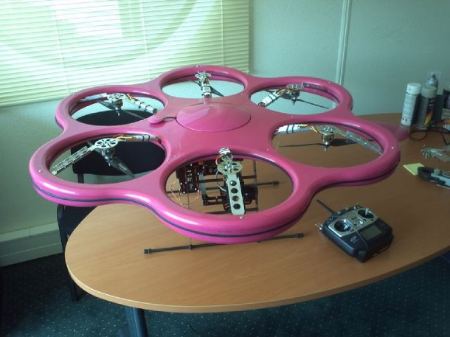
Check out this giant pink hexacopter. We see tons of quad copters here, but their bigger brothers/sisters the hexacopters don’t visit very often. When they do though, they get all dressed up as you can see in the picture above. This prototype frame is meant to protect both the props, and the innocent bystanders as you inevitably veer into something you shouldn’t. The frame is constructed mainly from carbon fiber and adds a total of about 1 Kg of weight to the copter. While it does fly, [AirvewLive] is looking for guidance on what prop/motor combo would yield more endurance. Anyone have some recommendations?
We know some of you will notice pretty quickly that he refers to this as a “ducted fan”. We realize it isn’t and we’ll forgive him this once because his build is so cool.
[thanks for the tip Mike]
















I wonder if adding meshes on top/bottom of propellers would reduce lift too much. At least it would prevent fingers/branches from entering them. Quick google revealed that some random hex mesh had 80% open area, but how that correlates to lift?
Variable pitch props. There’s at least one of those on HaD.
That one is insanely maneuverable and can stop nearly instantly in altitude changes.
Variable pitch would work, but the extra weight to control them is undesirable.
My advice, skip the dual blade props and move to quad or pentablade versions. (I used quad blades with great success back when quadrone prototyping was part of my employment.)
or, if one were really feeling froggy, skip props all together and try something I always wanted to:
Hook up with a 3d printer and make custom pitch turbine type rotors. Never got to try it as back in those days 3d printing was far to expensive and custom injection molds made new car buying look cheap.
http://www.ecalc.ch/xcoptercalc_e.htm
This is the website I used to optimise my quad specification. Fairly accurate results taking into account weight battery prop and motor. 1kg is heavy!!! Love the pink!
1Kg? Recommendation: don’t do that
Ya, I want to carve some serious lightening holes into that pink frame.
“Simplicate and add more lightness.” – William Bushnell Stout
I’m thinking military apps with GPS guidance and a video camera.
As is common, the original military prototyping is where these civilian models came from. Raytheon’s BikeShop was scratch building these around the turn of the century with the intent of creating troop portability drones for sniper spotting and elimination. (think quadcopter built around a wireless claymore mine…)
Ultimately R&D swapped over to big hunter killers like everyone else in those days mostly due to durability issues. With the advent of realtime satcoms, the portable applications have become somewhat obsolete for most theatres of operation.
http://www.aeroelectric.com/Reference_Docs/Misc_PDF/Bike_Shop.pdf
above design is circa 2004…however earlier prototypes lacked the wing control surfaces and were all props and gyros.
Regarding the effectiveness of the RC engine / propeller. This is it going to affect your flight time dramatically.
Which engine and propeller you use makes a big difference. A small change of the propeller with the same engine also makes a big difference.
Propellers of the “slow flyer” type is most effective. You must also have them in both CCW and CW.
For them, you want a small engine with high torque, so that it can reach its maximum RPM with such a “large propeller.” That means for example 750kv – 850kv motors at about 100-200 watts.
I built a test rig so that I could measure electrical energy (watts) and force / pressure (kg). It gave me a practical measurement of grams / watt.
This is the name of the game: g/W
2.5 g/W is normal for conventional RC (2000kv motor and 7×5 prop). So 100W gives you 250g lifting.
Ducted fan usually gives 1g/W or less.
If you are lucky and can find just the right combination of engine and propeller … 8g / W. 200W can then give 1.6 Kg lift.
Before you buy 6 engines and propellers, buy a couple of different engines and propellers, and test how effective they are.